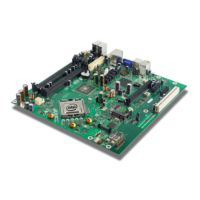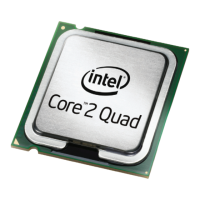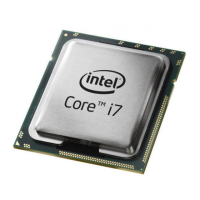Datasheet 29
Electrical Specifications
Table 19. FSB Differential Clock Specifications (1333 MHz FSB)
T# Parameter Min Nom Max Unit Figure Notes
1
NOTES:
1. Unless otherwise noted, all specifications in this table apply to all processor core frequencies
based on a 333 MHz BCLK[1:0].
BCLK[1:0] Frequency 331.635 — 333.364 MHz -
2
2. Duty Cycle (High time/Period) must be between 40 and 60%.
T1: BCLK[1:0] Period 2.99972 — 3.01536 ns 3
3
3. The period specified here is the average period. A given period may vary from this specification
as governed by the period stability specification (T2). Min period specification is based on -300
PPM deviation from a 3 ns period. Max period specification is based on the summation of +300
PPM deviation from a 3 ns period and a +0.5% maximum variance due to spread spectrum
clocking.
T2: BCLK[1:0] Period Stability — — 150 ps 3
4, 5
4. For the clock jitter specification, refer to the CK505 Clock Synthesizer/Driver Specification.
5. In this context, period stability is defined as the worst case timing difference between successive
crossover voltages. In other words, the largest absolute difference between adjacent clock
periods must be less than the period stability.
T5: BCLK[1:0] Rise and Fall Slew Rate 2.5 — 8 V/nS 5
6
6. Measurement taken from differential waveform.
T6: Slew Rate Matching N/A N/A 20 %
7
7. Matching applies to rising edge rate for Clock and falling edge rate for Clock#. It is measured
using a ±75 mV window centered on the average cross point where Clock rising meets Clock#
falling. The median cross point is used to calculate the voltage thresholds the oscilloscope is to
use for the edge rate calculations. Slew rate matching is a single ended measurement.
Figure 3. Differential Clock Waveform
High Time
Period
V
CROSS
CLK 1
CLK 0
Low Time
V
CROSS
Min
300 mV
V
CROSS
Max
500 mV
median
V
CROSS
median
V
CROSS
Median + 75 mV
Median - 75 mV
V
CROSS

